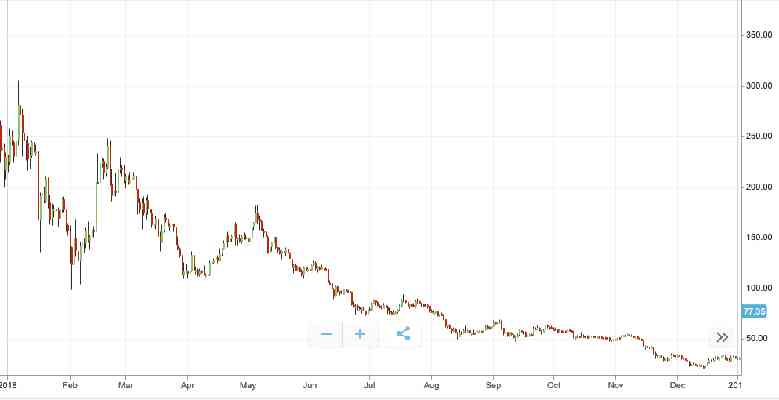Bitcoin and other cryptocurrencies might have had a good week so far , but it’s not quite enough to make up for this Nasdaq-listed cryptocurrency mining firm‘s 2018 losses.

In its 2018 financial report , released yesterday, cryptocurrency mining firm Riot Blockchain posted a $58 million loss.
According to the report, the firm generated $7.7 million in mining revenue, earning 1,081 Bitcoin (including conversions from Bitcoin Cash) and 3,023 Litecoin. This was done at its facility in Oklahoma City, where it’s been operating 8,000-plus miners since last June.
Despite the huge losses, Riot was able to maintain a positive gross margin of 33 percent. It puts its losses down to company liabilities totaling $45.2 million.
In simple terms, the company made a profit on its daily operations – mining cryptocurrencies – but when all things are considered, it made a loss. Due to non cash expenses like depreciation of hardware, and the drop in value of mined coins.
In April last year, Riot Blockchain was served with a subpoena from the Securities and Exchange Commission (SEC) investigating the company’s assets and possible investment assets. According to the report, the SEC investigation is still on going.
Riot Blockchain came to life in 2017 after it changed its name from Bioptix , and got into blockchain and cryptocurrency by acquiring a minority stake in Canadian digital currency exchange, Coinsquare. Riot still has a 12.1-percent stake in this business, at the time of writing.
Like “ Long Blockchain Corp ,” Riot’s shares jumped 50 percent in the days leading up to the change in name and company direction. In recent months though, it seems investors have got savvy and are no longer wowed by blockchain buzzword marketing like they once were.
It looks like Riot Blockchain will just be another mining firm that failed to turn a profit last year.
Did you know? Hard Fork has its own stage at TNW2019 , our tech conference in Amsterdam. Check it out .
Understanding blockchain is way easier if you think of it as an onion
Welcome to Hard Fork Basics, a collection of tips, tricks, guides, and advice to keep you up to date in the cryptocurrency and blockchain world.

In previous Hard Fork basics articles we’ve mentioned something called “blockchain layers.” Things like the Lightning Network , or even side chains are considered to be second layer protocols – they operate on top of, or alongside the protocol layer of a given blockchain.
However, blockchain has more than two layers, in fact, it can be split down to as many as five layers. Let me explain what this all means.
Communication networks as layers
In Blockchain Basics , Daniel Drescher describes blockchain as a software system made up of two layers; application and implementation. The application layer is responsible for the user facing components, and the implementation layer refers to everything that brings the application to life, like protocols and code.
However, these layers can be separated even further based on their specific function, as far as software systems go blockchain is pretty complex and is facing a number of challenges. We must also remember that blockchain isn’t purely software based, it also has a very specific network of physical components. Here’s how I propose we should think about the layers of the blockchain, from a non-technical point of view.
From layer zero to layer one
I propose that layer zero should concern the physical network infrastructure required to support Bitcoin and other cryptocurrencies. Think of it as the point at which the internet stops and the blockchain network begins.
In many ways, the blockchain itself can be considered as another layer on top of the internet, as without it, the blockchain wouldn’t function. Right now, the blockchain needs the internet to function. As such, layer zero is made up of the protocols, the connections, the hardware, the miners, and anything else that lays the foundation for making the blockchain a reality. This of this as the physical layer.
Layer one then, is where things start getting a little more abstract. When people say “the blockchain,” it’s probably this layer that they are referring to. This layer differs based on the specific blockchain being referred to, it might be the Bitcoin blockchain or the Ethereum blockchain.
This layer is responsible for specific protocols, consensus mechanisms, and anything else that ensures the base level functionality of a blockchain and its associated cryptocurrency. By Drescher’s description this is an implementation layer.
Layer two and beyond
However, blockchain isn’t that simple to abstract into just one implementation layer, oh no! Due to the nature of solutions like the Lightning Network, layer two has become known as a secondary implementation layer.
Some refer to layer two as “off-chain” solutions because they take some of the layer one functionality away from its native blockchain. This secondary chain, or layer two, then takes care of some of the processing, taking load away from the layer one blockchain. Layer two systems are often designed to address some of the blockchain‘s operational challenges like scalability.
The Lightning Network is a second layer solution in that it uses Bitcoin on a separate chain which is designed to process lots of small payments very quickly. When you join the LN you move some Bitcoin to it, and use that to transact with. When you leave the LN your Bitcoin is sent back to the layer one chain and is verified in the usual manner.
I propose that a third and final layer completes this model of a blockchain ecosystem. This, layer three, would contain dApps. This is where all non-cryptocurrency uses of the blockchain reside, these are things like gambling dApps and STEEM apps. Indeed, this layer itself could be abstracted to further layers depending on a given dApp and how it interacts with all the previous layers.
By Drescher’s description, this is effectively the application layer, it is the user facing decentralized app that should bring some real world, usable tool to life. It’s the layer responsible for things like Cryptokitties, so thanks layer three.
Things to bear in mind
Of course, this is an intentionally simple and non-technical perspective on blockchain as a series of layers. However, it should highlight to everyone, in someway, how different aspects of the blockchain should be thought of.
Change something in one layer and there may be knock-on consequences in the layer above or below.
This model of layers also does not consider things like wallets or exchanges; vital tools required for a successful blockchain and cryptocurrency ecosystem. However, these things do not always exist on a blockchain in their own right. Rather, they serve to interact with the blockchain, and permeate through all of its layers.
As the technology is adopted and developed further, there is the possibility that more layers will be created. However, understanding that ‘the blockchain‘ is more complex than just a single layer made-up of a distributed ledger is important for anyone’s knowledge.
Blockchain is a pretty abstract concept on the best of days, hopefully thinking of it as a series of layers, makes it a little less so.
First quarter 2019 crypto roundup: How did Litecoin perform?
Litecoin (LTC) was created back in 2011 as one of the earliest forks of Bitcoin. Like many other cryptocurrency projects, such as the Lightning Network, Litecoin promises to improve on Bitcoin by offering a cryptocurrency better suited to high volume, low value, everyday transactions.

This supposed “lite” cryptocurrency has a block time that it claims is about 25-percent less than Bitcoin’s. In theory, it should process and validate transactions much quicker.
Despite sounding like it solves many of the issues that plague Bitcoin, Litecoin has not reached the same market cap. That said, at press time, it’s still the highest ranking Bitcoin fork according to CoinMarketCap, taking 5th spot by market capitalization.
LTC/USD 2018 recap
Like most other cryptocurrencies, Litecoin finished off 2018 with a downward trend from where it opened the year.
It opened the year at $231.67 and made a gain of 38.5 percent in the first week to reach $320.78. This would be the highest price LTC would see all year. By February, its trading price dropped by nearly 63 percent bottoming at $119.54.
The Bitcoin spin off had a third rally across Q2 2018, where prices rose from $116.49 on April 1, to $168 by the end of the month.


But from there on, Litecoin was unable to escape the correction that plighted the entire cryptocurrency market last year. It ended December 2018 87 percent down on its opening value, closing the year at $29.36
LTC/USD 2019 Q1 review
Overall, Litecoin has got off to a strong start in 2019. Any new investors to this cryptocurrency will have seen gains on this particular coin over positions at the start of the year.
LTC opened the year at $30.99 and within 10 days witnessed a 25-percent jump to $38.94. Indeed, it’s certainly not in the same league as the rally LTC saw at the end of 2017, but it was a confident start to the year.
Unfortunately, this upward trend was short-lived. By mid-January LTC’s price dropped to levels inline with its year open. It spent the next four weeks hovering around a trading price of $30. While potentially disappointing for some investors, for those that held their nerve the outlook improved into the rest of the quarter.
Across a four day period from February 6 to 10, Litecoin’s price shot up by nearly 42 percent from a somewhat stable $32.20, to $45.71. This swift jump in LTC’s price marked the start of a period of sustained growth which continued until the end of the quarter.
LTC saw another substantial jump in the first week of March which saw its price jump from $45.28 to just over $56.
By the close of the quarter Litecoin was sitting a comfortable 93.7 percent up on its year open. Its trading price being a hair over $60.
Slow and steady wins the race
There have not been many huge swings Litecoin’s price this year. Investors looking to make big short term gains were likely left wanting. It has been, uncharacteristically for a cryptocurrency, acting positively and stable.
Indeed, 2019 is shaping up to be a big year for Litecoin, and this steady growth will likely continue until August when the coin is expected to undergo its reward halving. The halving will reduce the Litecoin mining reward from 25 LTC to 12.5 LTC per block.
This isn’t the first halving that Litecoin has undergone. LTC’s block reward first halved way back in 2015, and in the months leading up to the event its value rose by around 700 percent. Whether we’ll see such huge increases this year remains to be seen, but it won’t come as a total surprise if it does.
As one of the earliest forks of Bitcoin, Litecoin is one of the most proven cryptocurrencies. Its creator, Charlie Lee, may not blow its trumpet as loudly as other developers, but Litecoin has slowly and steadily continued to develop over the years with few signs of slowing. It’s managed to maintain its relevance in a competitive space.
As know-your-customer and anti-money laundering regulations get implemented across the globe, making cryptocurrency payments less anonymous. Lee has vowed to bring confidential transactions to the platform at some point in 2019. For those bullish on privacy coins, be sure to keep Litecoin on your radar as the year continues.
Looking forward
It looks to be a strong start to Q2 for Litecoin. Most markets saw a strong upheaval in prices, seemingly a knock on improvement from a surge in the price of Bitcoin. Litecoin jumped from around $60 to near $70 in a matter of hours. With prices increasing across the board, this could finally be a sign of the end of the bear market.
Litecoin’s speedy operation has certainly made it popular over recent years, and with Lee’s determination, it has developed a project that is seemingly standing the test of time.
Given Lee’s continued focus, and with Litecoin expected to witness another halving before the year is out, it’s certainly looking like “the faster Bitcoin” will continue to mature well in the eyes of investors. But of course, this is cryptocurrency, and anything is possible.
Want to get your hands on a share of $1,650,000 worth of Ethereum? eToro is giving away 0.1 Ethereum to the first 100,000 sign-ups of its new wallet . Now go claim your free Ethereum and sign up for the eToro wallet by clicking on the link here .











